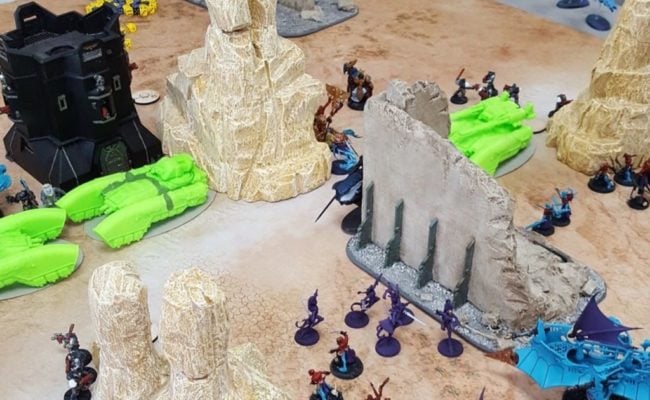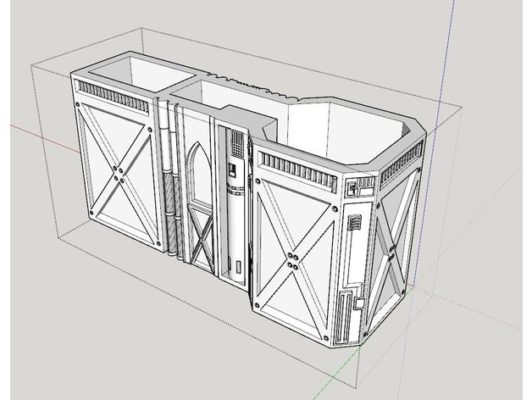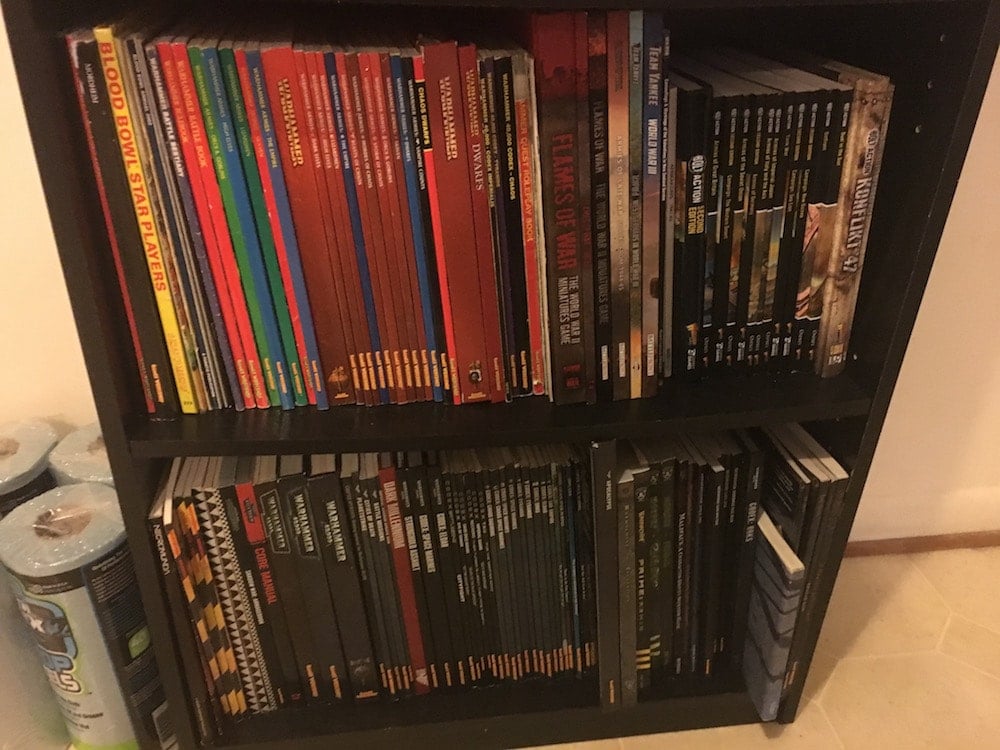3D Printing is(n’t) killing the miniature wargaming industry
Last week, there was a series of rather negative articles on Spikey Bits (and even worse facebook comments) regarding 3D printing that caused a bit of a stir in the 3D printing community. These started off with one regarding a Warhammer 40,000 tournament army that consisted of unpainted, 3D printed proxy models for an Adeptus Custodes army. It quickly devolved into the usual trope and gatekeeping from those who know next to nothing about 3D printing, accusing everyone who has a 3D printer of being a pirate, calling it IP theft, and comparing it to Chinese “yoyhammer” recasts. You can read it all here:
- How To End The Chinacast 3D Printing Proxy Crisis- SATIRE
- 3D Printing Threatens GW’s Revenue: Skitarii Dunerider Spotted!
- 40k Feels Bads: 3D Printed Army Wins a Tournament

Coincidentally or not, a day or so later, there were a bunch of takedowns of Warhammer 40,000 related files on thingiverse, including those by well known creators that might have walked a particularly fine line when it comes to fair use of IP (which we’ll get into later). The tone of these articles reminded me of some of the old sterotypes that get thrown about by anti 3D printing luddites, claiming at various times that there is no skill in it (not realizing that the miniatures that they purchase from the game store were most likely designed in CAD and had 3D printed masters before being “recast” in hard plastic or resin, that 3D is destroying the miniature wargaming industry etc, something that reminded me of some of the very negative feedback I got earlier in the year on Reddit when I posted a post about (mostly) finishing a 1500 Point New Zealand force for V3 Flames of War, where I’d 3D printed all the tanks (and my figures were from a 3rd party creator – plastic soldier company). I posted it around the place, and eventually I ran into the “3D printing will kill wargaming”/”why don’t you support X company”/”I bet you download your rulebooks” crowd:

The Reddit thread, went downhill pretty quickly for obvious reasons, half of which being that I was still in bed and hadn’t woken up yet, and the other half being that the person I was arguing with was the sort that spends their in the more “interesting” parts of reddit, full of conspiracy theories, and other rubbish:
So, I thought I’d lay out why I think that 3D printing (be it at home, or commercially) doesn’t harm the miniature wargaming industry, but in fact helps it grow.

So – let’s start with a bit of background. I’ve played miniature games since I was about 7 or 8 years old, starting with Heroquest, moving onto Warhammer Fantasy Battles (back when it was High Elves and Goblins in the Box), Warhammer 40,000 (2nd and 3rd Editions) and the original incarnations of Necromunda. At some point I was playing Rapid Fire with 20mm figures, while others in my games club (at that time the South Auckland Miniature Wargames Club in New Zealand) were playtesting this game that would eventually be called “Flames of War”. I took various breaks during university before selling up completely my last of my Necromunda, Gorkamorka and Blood Bowl collections before spending a few years traveling south east asia, meeting my wife and moving to the United States – I’d completely forgotten about miniature wargames. Then I saw it, a brand new version of Necromunda, and down the rabbit hole I went, and thats how I discovered 3D printing. It all started with a single file on Thingiverse, walls for Zone Mortalis boards (which I’ve still yet to print!) that resulted in my purchasing a 3D printer, and getting into printing terrain for our Necromunda boards.

There is no way my wife would have let me get deep into multiple game systems if it wasn’t for a 3D printer. Since then I’ve got back into (in one way or another) playing a wide manner of games at my Friendly Local Gaming Store (shout out to Eagle and Empire games in Alexandria, Virigina!) including:
- Bolt Action
- Konflict 47
- The 9th Age Fantasy Battles
- Warlords of Erehwon
- Cruel Seas
- Flames of War (incl Nam, Great War and Fate of a Nation)
- Team Yankee (incl Oil Wars)
- Gaslands
as well as picking up a bunch of second hand minis for
- Necromunda
- Warhammer 40,000
- Age of Sigmar
- Blood Bowl
- Epic 40,000

There is no way I would have got into any of these games without having access to a 3D printer. It all started with Bolt Action, realising that I could purchase a box of plastic figures, and then print tanks, trucks, artillery etc to create an entire army cheaply and easily. But this didn’t mean I stopped spending money at my friendly local gaming store – far from it. Instead, I started getting into more game systems, creating multiple armies, having forces for my friends to test out and give a new system a go. And every time I went to the local store I’d be purchasing something, due to the lower barrier to entry if a new game came out, I’d purchase:
- Rulebooks
- Dice and Accessories
- Paints, Primers & Glues
- Plastic and Metal Infantry
- Decals
- Gaming Mats
My spending habits changed, but the amount of time I spent gaming, and the amount that I spent on gaming actually increase. Instead of on company having a monopoly on my spend, it went wider (though I must say, Warlord Games, with their agnostic approach to miniatures is receiving the majority of my spending). I’m not going to say exactly how much my spending increased as a result, for rear my wife might eventually read this, but I can easily say, along with every other person I’ve spoken to, that access to a 3D printer has resulted in an increased spend and level of support for the local store, not less.
What about intellectual property and copyright?
A common argument against 3D printing in wargaming revolves around IP and Copyright, and in some cases there is some merit to this, especially in games where the company owns and has created the universe where the games take part, take Warhammer 40,000 for instance, in a post Chapterhouse World, GW owns the content of the game, and have made it very clear what their policy is and that they intend to enforce their IP where it is threatened, as well as more dubious attempts to protect rights that aren’t theirs such as attempting to claim ownership of the term “Space Marine” even though it has existed in Science Fiction since the 1930s, while Warhammer Fantasy Battles earlier editions were directly inspired and influenced by Lord of the Rings and Dungeons and Dragons. Their policies are quite clearly stated on their website:


The Chapter House ruling gave some clear legal precedents as to what is, and isn’t allowed (such as around shoulder pads etc). Though there are still many grey areas as to which is, and isn’t legally allowed. Back in 2016, Vice posted an article stating that with the fidelity of 3D printers being so low, that GW and other firms didn’t have much to worry about, since then, the availability of high quality settings for FDM printers, and sub $500 resin printers has changed that, and major companies will see direct competition from 3rd party accessories, designers and the like, which will sail incredibly close to the wind with regards to their IP policies.
Anecdotal evidence however appears to show IP lawyers reaching out to creators where they see something that is likely in breach and politely asking them to modify the files in some cases (and even providing guidance as to to to make them compliant), while in other cases (as with what happened last week, where a large amount of Warhammer 40,000 related files were removed) we are starting to see more takedown notices under the DMCA when files are hosted on websites like thingiverse. Generally speaking, as required by the law and in order to keep their safehabor protections, the sites will err in favor of the rights holder.
That said, this isn’t always the case, as with earlier in the year when the makers of World of Tanks issued DMCA notices to thingiverse in regards to creators TigerAce1945 and m_bergman. There was once again, lots of rumors and innuendo surrounding this incident, in the end it was nothing more than them defending their trademarks when it came to things that were tagged “World of Tanks” when it came to user generated collections, and how things showed up in search, it also didnt’ help that things that contained the words ‘World” “of” “Tanks” could theoretically show up in searches for said search term, and its highly likely that every single “World” War Two pack “Of” “Tanks” could show up in that type of search! Regardless, they challenged the takedown and the files were reinstated.
When it comes to historical models, most AFVs were designed for national armies for nation states (many of which no longer exist anymore), and are public domain. This makes historical models much, much safer from an IP point of view, there are still potential issues with trademarks from companies that still exist, but this is a hornets nest that still hasn’t been shaken. As it stands, the historical wargaming wargaming scene is likely to be far more friendly to 3D printed models from an IP point of view.
Last by not least, there is the more generic end fo fantasy wargaming, where forces are based on myths and legend. Generic orcs, goblins, elves, dwarves, trolls and dragons are safe from any IP, while those that are directly linked to a game system, film or novel are likely to have some from of IP protection. The same goes for light sci fi, where space elves, space orcs, space goblins and space dwarves are IP free, while Orks, Gretchin, Eldar etc, are more likely to be protected as are any particular design elements that are peculiar to a particular gaming system.
What does this mean for miniature wargaming industry?
As with other industries that have had to deal with digitization, such as photography, music, taxis, hotels etc, the miniature wargaming will be disrupted by 3D printing and other emerging technologies. There will be clear winners and losers in this space. Some of the old guard may fail to adapt, such as with Kodak during the age of digital cameras (who would have thought 20 years ago, that the most popular form of photography would be on our cell phones for instance), but this doesn’t mean it will kill the industry, only disrupt it. There is now lower barriers to entry to create new game systems, new scales, rules without miniatures, or digital distribution of miniatures and rules. Larger entrenched firms will lose their monopolies, or they may adapt if they take advantage of possibilities for customization and niches that were not profitable to manufacture when it required 10s of thousands of units to justify the production process, creating a long tail business model of miniature wargaming where innovation is democratized amongst the users.
Eventually major games companies are going to have to adapt, just as they did to the internet and piracy of rulebook PDFs, by making legal, digitally watermarked versions available online. This means selling STLs or similar of designs for products (perhaps in the Warhammer world we may see this happen via GW offshoot Forge World, for conversion parts where it’s not cost effective to mass manufacture?). Other new technologies such as blockchain and digital ledgers might be used for recording digital rights management for 3D printing.Perhaps we will see companies producing their own 3D printers with some form or rights management, subscription services for files similar to patreon, branded filament or resin etc once 3D printing becomes more user friendly for the average consumer.
In other areas, especially historical miniatures, we are already seeing this with an explosion of grown in the availability of STL packages being available here or on other sites such as thingiverse, myminifactory or CG trader. 3D printing is here, and it’s here to stay. We may see (at least to begin with) restrictions on 3D printed models at tournaments, but this only makes sense at events that are put on, or sponsored by miniatures manufacturers, or stores that are specifically trying to sell their own ranges of miniatures, but this will only be in the short term, as the practice is normalized.
What about the “ethics” of using 3D printed models?
When it comes to proxies for models where it’s clearly someone else’s IP, this is a pretty big grey area, and is really going to depend on where you are playing. I’d strongly recommend against taking entire armies or whole models to your local GW store for instance, considering their stance on 3rd party conversions, let alone 3D printing. I’ve got a fair few space dwarves I’ve printed as a squat kill team, and some other parts here and there that I have for home use.
When it comes to your FLGS however, things might be different. I’d always suggest asking first. I play at my local store with quite a few 3D printed models mixed in with ones I’ve purchased at the store, which I use all the time. In fact you’d be hard pressed to find me playing a game without them. But then honestly what is the difference between me playing Flames of War with some Zvezda or PSC models and some that I’ve printed myself using the m_bergman files, or something I’ve purchased elsewhere – virtually nothing. The same goes with playing Bolt Action with Rubicon tanks, or 1/48 scale models.
That said, when playing at your FLGS abide by the golden rule – DBAD (Don’t be a dick). That means, don’t make big deal about your models being 3D printed unless asked, under no circumstances try anything silly like selling them to customers, ask permission before bringing/using them and above all – support your FLGS by actually buying something when you are there, whether it’s a rulebook, gaming accessory, paint or infantry. Demo games at home and bring new customers to the store. The staff will notice, and have a far more positive opinion on 3D printing if you are a paying customer. 3D printing shouldn’t replace your gaming habits, it should supplement them instead. Offer to supply terrain or other things that might be useful to the store, basically – make sure you represent the 3D printing community in a positive light. Only use high quality prints, and make sure you paint them – you want people to see 3D prints looking good, and not some unpainted, poorly based fluro green proxy of the type that sparks articles on Spikey Bits.
And there you have it. 3D printing isn’t a threat to the industry, but it will change it. Home taping never killed music. MP3s never killed music. Spotify hasn’t killed music. We still have music, and always will. But, just like in the music industry, those who do not adapt will be disrupted, while those who integrate it into part of a wider strategy will prosper. So go forth, print stuff, paint it, and show 3D printing in a positive light to the wider gaming community.